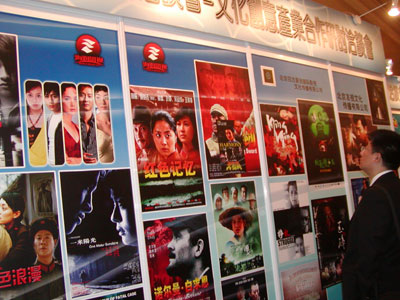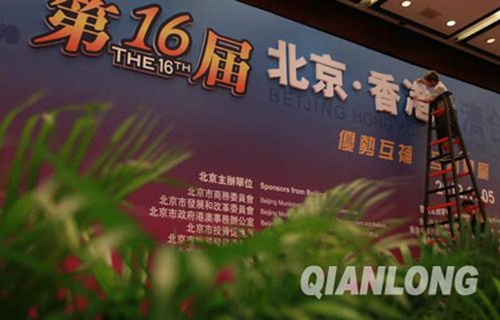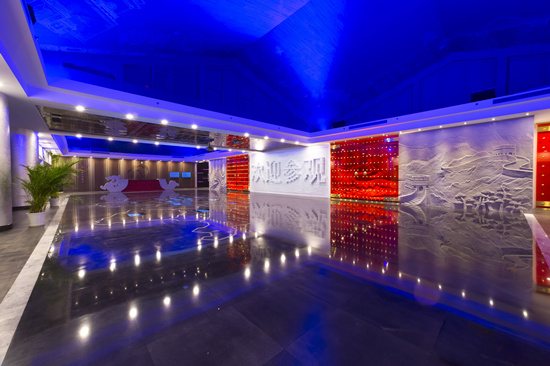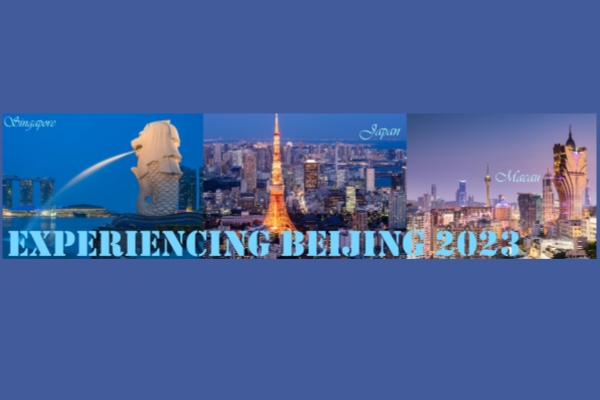The 20th Beijing-Hong Kong Economic Coperation Symposium
About
The 20th Beijing-Hong Kong Economic Cooperation Symposium was held in Beijing from November 3 to 4, with a theme of "building towards common prosperity through exchange of elements, two-way investment and shared opportunities".
The Beijing-Hong Kong Economic Cooperation Symposium has been held annually in Beijing and Hong Kong by turns since 1997. The Symposium functions as a bridge joining together two local governments, enterprises and investors to promote common prosperity and development in Beijing and Hong Kong.
A total of 13 special events in Beijing covering technology, culture, youth entrepreneurship and the Beijng-Tianjin-Hebei integrated development were promoted in 18 major activities during the two-day Symposium.
The notion of two-way investment has been emphasized since 2014 at the Symposium. Hong Kong has been the top source of foreign investment into Beijing for a long time. Hong Kong is also the most heavily invested region for Beijing companies' outbound investment. From January to September 2014, Beijing's direct investment in Hong Kong more than doubled to $ 1.51 billion. By September 2014, the total direct investment of Beijing in Hong Kong reached $4.151 billion, accounting for 24.64 percent of Beijing's total outbound direct investment.
Investment from Hong Kong reached US$5.14 billion in the first eight months of 2016, accounting for 41.5 percent of Beijing's utilized foreign direct investment (FDI), according to the Beijing Investment Promotion Bureau. Beijing's direct investment in Hong Kong reached 7.57 billion U.S. dollars, up by 127.4 percent year-on-year, from January to August in 2016, making HK the top overseas investment destination for Beijing-based companies.
Schedule
The Beijing-Hong Kong Economic Cooperation Symposium was held from November 3 to 4 in the Beijing Hotel. A total of 18 events were organized, including:
1. Four major activities:
a. Opening ceremony;
b. Meeting between municipal leaders and commercial and industrial representatives from Beijing and their Hong Kong counterparts;
c. Round table conferences among well-known entrepreneurs from Beijing and Hong Kong;
d. Signing ceremony of major projects regarding two-way investment and private investment in Beijing and Hong Kong.
2. Thirteen thematic activities in five sessions.
Session 1: Opening up of the service industry, consisting of four special activities including:
a. "Focus on new opportunities and share new business opportunities" - to help Hong Kong enterprises enter Beijing's service industry and to promote the Beijing Fair as a way to open up the service sector in the first half of this year;
b. "Financial innovation, hand in hand" - special activity for financial services cooperation in Beijing and Hong Kong;
c. "Contact the world, business opportunities" - special coordinated development activity of the Internet information service industry in Beijing and Hong Kong;
d. "Integration, Innovation and Development" - Beijing & Hong Kong Cultural and Creative Industry Cooperation.
Session 2: Innovation and entrepreneurship
The following three special activities were provided:
a. “Joint establishment of a global scientific innovation center” – a special activity of scientific and technological cooperation between Beijing and Hong Kong;
b. “Achieving an entrepreneurial dream through sharing resources” – a special activity for youth innovation and entrepreneurship cooperation and exchange in Beijing and Hong Kong;
c. "Finding infinite business opportunities in creativity" - Beijing and Hong Kong Museum collection development cooperation activities.
Session 3: Joint efforts in two-way investment
A thematic activity: "policy opportunity: the Belt and Road leads two-way investment in new directions" - Beijing, Tianjin and Hebei cooperate with Hong Kong in two-way investment and trade project negotiations.
Session 4: Coordinated development of Beijing, Tianjin and Hebei and investment promotion of the development zones
Two special activities occurred:
a. Investment Promotion of the development zones in Haidian, Fengtai, Shunyi (Tianzhu Comprehensive Free Trade Zone) and other development zones;
b. Investment Promotion of collaborated development of Beijing, Tianjin and Hebei.
Session 5: Public service
The following three special activities were arranged:
a. "Strengthening Energy Exchanges between Beijing and Hong Kong and Promoting the Common Development of the Two Areas" -- Beijing-Hong Kong City Electricity, Refined Oil, Gas Safety and Pipeline Protection Exchange Activities;
b. "People-oriented and Optimized Regulatory System” -- special activity of medicine and food safety cooperation of Beijing and Hong Kong;
c. "Diversified Participation and Collaboration -- PPP Model to Boost Health Care Reform and Development in Beijing and Hong Kong" - special activity for Beijing-Hong Kong hygiene and health cooperation.
3. Consultation and discussion on innovation, entrepreneurship and development opportunities in Beijing and Hong Kong.
Historical Review
Reaching a new cooperation mode between Beijing and Hong Kong
The First Session in 1997
Since the reform and opening up, Beijing and Hong Kong have been seeking a closer and more effective way to promote economic and trade cooperation. As early as 1992, Beijing had sent a delegate to introduce projects in Hong Kong and received positive responses from Hong Kong business people who began to show an increasing intention to invest in Beijing real estate; over time, such intentions have become more and more solidified.
"The return of Hong Kong in 1997 was an opportunity," said Man Qunjie, director of the Beijing Investment Promotion Bureau, "if we are talking about the investment amount or the project volume." By 1997, both parties had agreed to promote trade and economic cooperation in the form of the Beijing-Hong Kong Economic Cooperation Symposium and decided to host the first Beijing-Hong Kong Economic Cooperation Symposium in Beijing in October of that year.
The initial workshop was divided into two parts: a seminar and a fair. There were 93 units participating in the first fair. There were 16 Beijing-Hong Kong joint venture projects with a total contract value of US $ 1.46 billion, and 13 foreign investment projects were signed for more than 100 million US dollars. Although the number of participants, the number of projects and the size of the negotiations cannot be compared with today, the fair created a new model of cooperation between Beijing and Hong Kong, and has been evolving ever since. It has become an effective mode of regional economic and trade cooperation.
Beijing increased the role of non-governmental institutions
The Fourth Session in 2000
"What impressed me most is that when I saw the sponsor lists of the first Beijing-Hong Kong Economic Cooperation Symposium, all the institutions involved on the Beijing side were government branches; however, on the Hong Kong side all the sponsors were business chambers except the Trade Development Bureau, a semi-official organization,” said Man Qunjie.
By 1999, the planning of the Zhongguancun Science Park had been approved by the State Council. The Capital Science and Technology Group, responsible for investment promotion of programs in Zhongguancun, got the first chance to take part in the Symposium as a non-governmental institution.
In 2000, the leaders of Beijing Municipality made it clear that the organizers of the Beijing-Hong Kong Association should increase the number of chambers of commerce and associations communicating and working directly with the Hong Kong Chamber of Commerce. So in this session, the Beijing International Chamber of Commerce, the Beijing Municipal Federation of Industry and Commerce, and the Beijing Foreign Investment Enterprises Association participated as sponsors. At the same time, other government agencies, except the Beijing Municipal Foreign Economic and Trade Commission, started to break away from the Symposium as sponsors.
Beijing Recruits Foreign Talents for the First Time
The Sixth Session in 2002
Talent recruitment caught people’s attention when it first started at the Beijing-Hong Kong Economic Cooperation Symposium in 2002, where Beijing was able to directly conduct foreign recruitment.
The Beijing Municipal Personnel Bureau provided 285 jobs in more than 100 enterprises in Beijing, including senior managers and professionals in the medical, health, pharmaceutical, financial and tourism industries. All the posts provided suitable salaries, annually no less than 200,000 yuan.
“Self-guided Tours” give Hong Kong new opportunities
The Seventh Session in 2003
Since the 7th session of the Symposium, Hong Kong has made adjustments in its investment environment, policies and talent introduction. It has also vigorously promoted itself in Beijing to attract investment capital from the mainland.
With the increasing trade and economic cooperation between Hong Kong and the mainland and the growing demand for mainland talents, the Hong Kong Government gradually eased the restrictions on mainland talents working in Hong Kong. In July 2003, Hong Kong introduced the Mainland Talents Scheme, which unified the employment conditions for mainland and foreign residents working there, cancelled industry restrictions, and supported residence in Hong Kong for applicants’ spouses and unmarried dependent children. By early 2015, more than 72,000 applications had been approved.
In order to enhance investment from mainland enterprises, InvestHK launched a one-stop service for office and residential leasing, staff recruitment, business registration and other relevant procedures.
After the outbreak of SARS in 2003, Beijing allowed citizens to visit Hong Kong as individuals, which gave Hong Kong a new opportunity. Visitors to Hong Kong encouraged the European and American companies that wanted to enter mainland China to open stores or set up headquarters in Hong Kong. This reduced the companies’ investment risk and stimulated Hong Kong's employment.
Owing to self-guided tours, this year’s Beijing-Hong Kong Economic Cooperation Symposium received the most Hong Kong guests, more than 400. "Olympic and Beijing Major Project Promotions" were organized and 177 investment projects, involving a total investment of $ 9.7 billion, were launched.
Cooperation expanded to people’s livelihoods
The 15th Session in 2011
Over time, cooperation between the two cities was no longer limited to financial matters, but extended to areas related to people's livelihoods, covering more diversified fields. This year’s session focused on talent exchange, housing security, health cooperation, rail transportation and 14 other important areas, the most over the past few years.

[Photo/beijing.qianlong.com]
In 2006, the first Beijing-Hong Kong Film & TV Cooperation Forum in ten years was held in the Ritz-Carlton Hong Kong Hotel, leading to signing ten major projects.
In fact, the investment focus had shifted to municipal infrastructure construction in 2001. In 2005, in-depth cooperation occurred in urban construction, retail and catering, cultural industry and other aspects related to people’s livelihoods.
Rail transit construction has been a focus of both Beijing and Hong Kong. In 2006, agreements related to Metro Line 4, which had been promoted in the Beijing-Hong Kong Economic Cooperation Symposium for many years, were finally signed. Beijing MTR Corporation Limited, the "investor" of Line 4, is the first foreign invested cooperation company in the urban railway transportation sector in mainland China. It is also the first enterprise to use the "PPP" mode of government and social capital cooperation to invest in rail transit. Today, BJMTR is invested in and operates Daxing Line, Line 14 and Line 16. BJMTR has achieved 119.5 billion yuan in Beijing projects and total investment of 34.6 billion yuan.
This resulted from mutual efforts to gradually expand zero tariffs since 2003, marking a new stage of the Beijing infrastructure investment and financing system. The tariff system proved conducive to introducing advanced international subway construction and operational concepts, thus improving Beijing subway operations and service.
From the introduction of hospital equipment to joint establishment of general hospitals, from film co-production to large-scale cultural cooperation, the Beijing-Hong Kong Economic Cooperation Symposium has been a bridge connecting both sides as well as a witness of their deepening cooperation. Last year, Beijing expanded the opening of the service sector, providing an even broader space for practical cooperation.
The greatest number of signed projects with cultural and creative ones first discussed
The 16th Session in 2012

Staff set up signage at the venue of the opening ceremony of the 16th Beijing-Hong Kong Economic Cooperation Symposium. [Photo/beijing.qianlong.com]
From 2008 to 2010, the Beijing-Hong Kong Economic Cooperation Symposium was influenced by the international financial situation. Hong Kong suffered from economic weakness, but its investment in Beijing still tended to grow on a year-on-year basis. Although the number and amount of contracts signed in the three Symposiums were not outstanding, the total trade volume between Beijing and Hong Kong in 2008 was 13.7 times that of their initial cooperation in 1997. Hong Kong has been the top foreign capital source of Beijing for a long time.
In 2012, signed projects at the 16th session of the Beijing-Hong Kong Economic Cooperation Symposium broke the record in both quantity and size. A total of 10.1 billion US dollars was committed, equivalent to 63.63 billion yuan.
In addition, as domestic copyrights gained increasing attention, Beijing set out to learn how to develop its culture and creative industry from Hong Kong, so a special in that area was introduced to the Symposium. The two sides signed an agreement on cultural and creative industry cooperation worth 13.96 billion yuan. Hong Kong is an international financial center and has rich international financial talents. Therefore, more Beijing companies began to explore the international market from Hong Kong.
"Zhongguo Zun (China Zun Tower)", Beijing Metro Line 14, Beijing Lize Financial Business District, and Phase II of Beijing Maolong Cultural and Creative Industrial Park construction were all signed in this session.

 Responsibilities of the SOCAAC
Responsibilities of the SOCAAC Experiencing Beijing 2023
Experiencing Beijing 2023